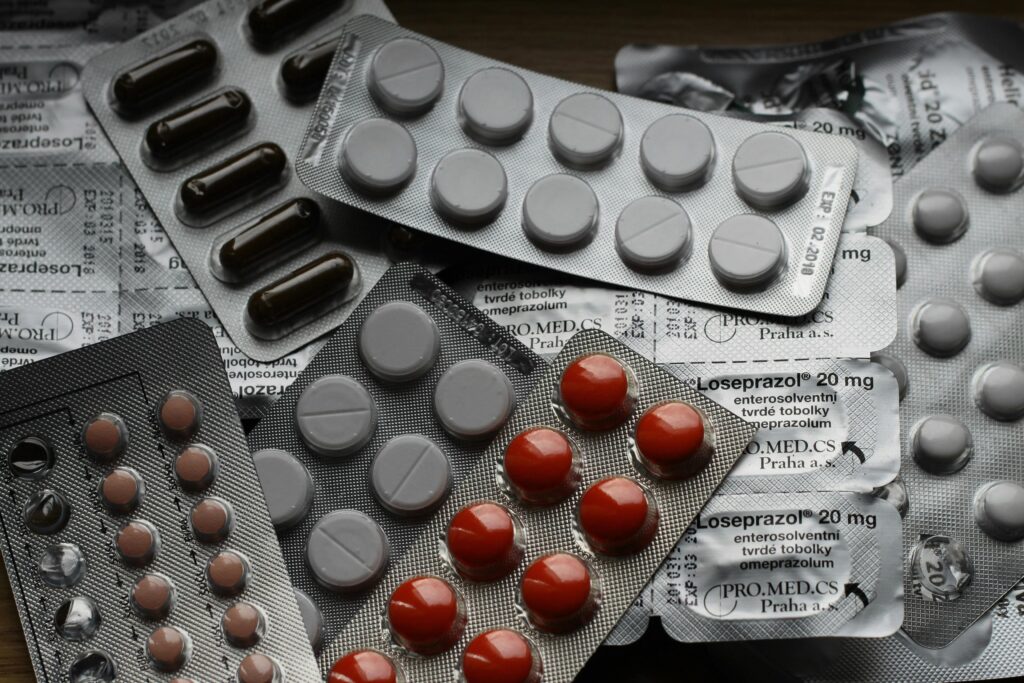The recently announced 100% tariff on branded and patented pharmaceutical imports by US President Donald Trump on September 25, 2025, effective October 1, represents a watershed moment in international trade relations that could fundamentally reshape the global pharmaceutical landscape. This aggressive trade policy, aimed at compelling foreign pharmaceutical companies to establish manufacturing facilities within the United States, poses significant implications for India’s pharmaceutical sector and global healthcare accessibility.

The Scale and Scope of US-India Pharmaceutical Trade
India’s pharmaceutical industry stands as the world’s third-largest drug producer by volume and holds the distinction as the “pharmacy of the world,” contributing 20% to the global export of generic medicines. The economic magnitude of this relationship is substantial, with India’s pharmaceutical exports reaching USD 30.5 billion in FY 2025, marking a 9.3% increase from the previous year. The United States serves as India’s largest export market, accounting for 31% of India’s total pharmaceutical exports, valued at approximately USD 8.7 billion in FY 2024.
The dependency is mutual and critical. India supplies over 45% of generic drugs and 15% of biosimilar drugs used in the US market. American consumers fill approximately 90% of their prescriptions with generic medications, many of which originate from Indian manufacturers. This relationship has generated substantial cost savings for the US healthcare system, with Indian-made medicines saving USD 219 billion in healthcare costs in 2022 alone and USD 1.3 trillion between 2013 and 2022.
Impact Assessment: Immediate Market Reactions and Long-term Implications
Financial Market Response
The pharmaceutical sector experienced immediate turbulence following Trump’s announcement. The Nifty Pharma index fell nearly 2% on September 26, 2025, with all 20 constituent stocks trading in negative territory. Major Indian pharmaceutical companies witnessed significant declines, with Sun Pharmaceutical Industries dropping 3.4% and other industry leaders like Cipla, Dr Reddy’s Laboratories, and Biocon experiencing similar losses.
Operational Impact on Indian Companies
The tariff policy primarily targets branded and patented drugs, a segment where multinational pharmaceutical giants traditionally dominate. However, uncertainty looms over whether complex generics and specialty medicines from India might also fall under scrutiny. Several major Indian pharmaceutical companies, including Dr Reddy’s, Aurobindo Pharma, Zydus Lifesciences, Sun Pharma, and Gland Pharma, derive between 30-50% of their total revenues from the American market, making them particularly vulnerable to any expansion of tariff scope.
The Indian Pharmaceutical Alliance has clarified that the current tariff applies specifically to patented and branded products, not generic medicines, potentially limiting the immediate impact on the bulk of Indian exports. Nevertheless, industry analysts warn that any future extension of tariffs to generic drugs could materially alter the growth trajectory of Indian pharmaceutical exports.
Strategic Responses and Mitigation Measures
Manufacturing Facility Investments
Several Indian pharmaceutical companies have proactively established or are developing manufacturing facilities in the United States to mitigate tariff exposure. Biocon has recently commissioned its US manufacturing facility in Cranbury, New Jersey, with an annual production capacity of two billion tablets, following a USD 30 million investment. Similarly, major players like Cipla, Dr Reddy’s Laboratories, and Lupin already maintain manufacturing facilities in the US, positioning them advantageously against the new tariff regime.
Market Diversification Strategies
Indian pharmaceutical companies are increasingly exploring market diversification to reduce their dependence on the US market. While the US represents the most lucrative market for Indian pharmaceutical exports, companies are investing in research and development, exploring new partnerships, and expanding into European, African, and Latin American markets.
Global Healthcare Supply Chain Implications
Supply Chain Vulnerabilities
The pharmaceutical supply chain has become increasingly globalized and concentrated, with significant dependencies on specific geographic regions. European countries demonstrate 74% dependency on Asia for active pharmaceutical ingredients (APIs), with China responsible for almost 70% of this dependency. China controls approximately 80% of the global generic API supply chain, while India serves as a critical supplier of finished pharmaceutical products.
The COVID-19 pandemic exposed these vulnerabilities, highlighting how geopolitical tensions, trade restrictions, and concentrated sourcing can lead to significant supply chain disruptions. The current tariff policy represents another stress test for this interconnected system.
Alternative Supply Sources
Global pharmaceutical companies have been implementing diversification strategies to manage supply chain risks. Multi-sourcing has become standard practice, with companies qualifying suppliers across different countries for critical products. Geographic diversification efforts have expanded beyond China and India to include countries like Vietnam, Indonesia, Mexico, and Eastern European nations.
However, qualifying new suppliers requires significant investment and time, with FDA guidelines potentially requiring months for requalification processes. This timeline constraint limits the immediate ability of pharmaceutical companies to respond to tariff-induced supply chain disruptions.
Economic Consequences for US Healthcare System
Cost Implications for Consumers
The implementation of 100% tariffs on branded pharmaceutical imports could lead to significant price increases for American consumers. Generic drugs, which account for 90% of US prescriptions but only 1.2% of the country’s healthcare budget, help maintain affordability in the healthcare system. Any disruption to the supply of cost-effective Indian generics could force American patients to either pay higher prices for medications or face potential shortages.
Healthcare providers, insurers, and patients could experience increased out-of-pocket costs, while public health programs like Medicare and Medicaid may face ballooning expenses. The ripple effects could worsen medication non-adherence, delay treatment for chronic illnesses, and widen existing health disparities.
Systemic Healthcare Risks
The US healthcare system’s heavy reliance on Indian pharmaceutical imports creates systemic vulnerabilities. Hospitals and clinics dependent on Indian-manufactured medications for up to 90% of their daily medicine supply could face severe operational challenges if supply chains are disrupted. Critical areas such as oncology, diabetes management, cardiovascular care, and infectious disease treatment could be particularly affected.
Policy Analysis and Strategic Considerations
National Security Justification
Trump’s tariff announcement cites “National Security and other reasons” as justification, stretching the bounds of executive authority under Section 232 investigations. The policy reflects broader concerns about pharmaceutical supply chain security and the need to reduce dependence on foreign manufacturing for critical healthcare products.
However, experts argue that this approach may be counterproductive, potentially driving the US to rely more heavily on Chinese manufacturers for life-saving medicines, which could undermine Washington’s own national security objectives.
Long-term Industrial Policy Implications
The tariff policy represents an attempt to incentivize domestic pharmaceutical manufacturing through protectionist measures. While some multinational companies like Eli Lilly and Johnson & Johnson have announced new investments in US facilities, the complexity and time requirements for establishing pharmaceutical manufacturing capabilities suggest that meaningful reshoring will require years to achieve.
The policy also reflects a shift from country-specific to product-specific tariffs, signaling that other sectors beyond pharmaceuticals could face similar measures.
Regional and Global Ramifications
Impact on Developing Countries
The disruption of established pharmaceutical supply chains could have particularly severe implications for developing countries that depend on affordable Indian generics. India supplies nearly half of the world’s vaccines and over 50% of global vaccine demand. Any reduction in India’s pharmaceutical export capacity could affect global health security and access to essential medicines in low- and middle-income countries.
Competitive Dynamics
The tariff policy may accelerate the competitive repositioning of global pharmaceutical suppliers. Countries like Vietnam, Indonesia, and other Southeast Asian nations could benefit from supply chain diversification efforts. However, the specialized nature of pharmaceutical manufacturing and the stringent regulatory requirements limit the speed at which alternative supply sources can be developed.
Recommendations and Future Outlook
For Indian Pharmaceutical Companies
Indian pharmaceutical companies should continue investing in US manufacturing facilities to maintain market access while simultaneously diversifying their global footprint. Enhanced focus on complex generics, biosimilars, and research and development capabilities will be crucial for long-term competitiveness.
Companies should also strengthen regulatory compliance capabilities and explore strategic partnerships with US-based entities to navigate the evolving trade environment.
For Policy Makers
Both US and Indian policymakers should prioritize negotiated solutions that balance legitimate security concerns with the need for affordable healthcare access. The interconnected nature of pharmaceutical supply chains requires collaborative approaches rather than unilateral trade measures.
Investment in supply chain transparency and resilience should be prioritized, including the development of early warning systems for potential disruptions and the establishment of strategic reserves for critical medications.
For Healthcare Stakeholders
Healthcare systems should develop contingency plans for potential supply chain disruptions, including alternative sourcing strategies and inventory management protocols. Public health authorities should monitor the impact of trade policies on medication availability and affordability, particularly for vulnerable populations.
Conclusion
The US tariff on pharmaceutical imports represents a significant challenge to the established global healthcare supply chain ecosystem. While the immediate impact may be limited to branded and patented drugs, the policy creates uncertainty that could fundamentally alter trade relationships and supply chain strategies in the pharmaceutical sector.
The interconnected nature of modern pharmaceutical supply chains means that protectionist measures in one country can have far-reaching consequences for global health security and access to essential medicines. As this policy unfolds, stakeholders across the pharmaceutical ecosystem must navigate the balance between legitimate security concerns, economic interests, and the fundamental goal of ensuring affordable access to life-saving medications for patients worldwide.
The ultimate success or failure of this policy will be measured not only in terms of domestic manufacturing growth but also in its impact on healthcare affordability, supply chain resilience, and global public health outcomes. The pharmaceutical industry’s ability to adapt to this new trade environment while maintaining its essential mission of providing accessible healthcare solutions will determine the long-term implications of this significant policy shift.

